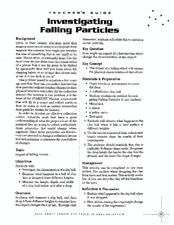Curated OER
Atomic Structure
In this atomic structure learning exercise, students select answers to 8 fill in the blank questions on subatomic particles from the drop down box.
Curated OER
Isotope Notation
In this chemistry activity, students calculate protons, electrons and neutrons in ions and neutral atoms to complete 2 charts.
Curated OER
The Structure of the Elements
In this chemistry worksheet, students study the composition of the elements in the periodic table using an interactive website.
Curated OER
Chemistry E3 Lesson Plan
Ninth graders perform a series of experiment to investigate heat transfer and phase changes. In this physical science lesson, 9th graders identify and calculate the different subatomic particles. They explain the importance of scientific...
Curated OER
Cosmic Rays
Students study cosmic rays and the energy behind them. In this atmospheric lesson students complete a cosmic ray telescope project.
Curated OER
Build Your Own Atom
Students build a model of an atom using an online program. In this chemistry lesson, students discuss the different parts of the atom. They complete an independent research about their chosen element.
Curated OER
Subatomic Particles Quiz
For this subatomic particles quiz worksheet, students complete an on-line quiz, clicking on questions and matching answers, scoring 1 point for each correct answer. A printed version is available.
Curated OER
Subatomic Particles Quiz #2
In this subatomic particles quiz worksheet, students complete an on-line quiz, clicking on questions and matching answers, scoring 1 point for each correct answer. A printed version is available.
Curated OER
Investigating Falling Particles
Students investigate the characteristics of a clay ball. In this particles lesson students examine what happens to a ball of clay when it is dropped from different heights.
Curated OER
Analyze Your Sand Samples
In this sand sample worksheet, students analyze a sample of sand and indicate the site the sand was from, the size of major and minor particles, the presence of shells and magnetic particles, the colors present and the shapes of the sand.
Curated OER
Water Velocity
In this water worksheet, students use a graph comparing particle diameter with stream velocity to complete 6 fill in the blank questions.
Curated OER
Bellwork for Week 11
In this bellwork instructional activity, students answer questions about chemical and mechanical weathering, particle size, and the soil profile at the start of class.
Curated OER
Elements and Ions Worksheet
In this elements and ions instructional activity, students complete a table given an element, the symbol, or the number of subatomic particles and they must complete the rest of the table. The do the same for five ions. They also write...
Curated OER
Why Do Atoms Combine?
In this subatomic particle worksheet, students will read the important discoveries throughout history of the neutrino. Based on this information, students will complete 4 short answer questions.
Curated OER
Significant Figures and Conversions
In this chemistry learning exercise, students identify how many significant figures are in each of the numbers listed. Then they determine the velocity in meters per hour for a subatomic particle. Students also determine how many...
Curated OER
Structure of the Atom
Students identify the location and change of the subatomic particles of an atom. They name the three subatomic particles. Students review what they can recall about subatomic particles. They are given a worksheet on the subatomic...
Curated OER
Color Me Hot
Seventh graders use the scientific method, to observe, record and analyze the data they gathered. They make observations using their five senses. Students compare, contrast and draw conclusions based on the observations and data...
Curated OER
DON'T TREAD ON ME
Students explore how the habits and practices of people affect the soil and growth of plants. They are introduced to the phrase "soil compaction." Students play the Soil Particle Game in the related activities section. They go outside...
Curated OER
Matter & Subatomic Particles
Seventh graders divide into small groups to construct several models. Each group builds with an accompanying chart showing the colors of gumdrops used for the protons, electrons, and neutrons.)
Curated OER
Properties of Waves
Third graders observe and investigate wave properties and compare the properties of particles and waves. They fill a pie pan half full with water, place a toothpick in the center of the pie pan, then drop a marble into the pan and...
Curated OER
About Magnets
Second graders conduct simple experiments , observe and explain what they discovered. In this simple experiments lesson students design a magnet and make a compass.
Curated OER
Atoms, Elements, Molecules, and Compounds
In this elements worksheet, students review the Bohr model and define negative and positive subatomic particles. Students compare molecules and compounds. This worksheet has 11 short answer questions and 4 problems to solve.
Curated OER
The Radium Girls
In this radium learning exercise, 7th graders determine the substance used to make the dials of watches glow in the early 1900's. Then they explain why radium glows and what the three most common types of emissions from radioactive...
Curated OER
Tracking Unseen Particles
In this science worksheet, students look for the answers to the problems that are related to the identification of particles that move between different points.

























